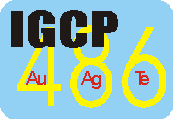Au-Ag-telluride-selenide deposits
PROJECT LEADERS: Nigel John Cook (Norway), Kari Kojonen (Finland)
DURATION: 2003-2007
The project focuses on studies of Au-Ag-telluride-selenide mineralisation of all types (epithermal, magmatic, metamorphic) and attempts to bridge the gap between scientists working in the laboratory and those working in the field from the microscopic- to orogen-scales. We will exploit the apparent gap between scientists working in the laboratory, either on experimental or microanalytical aspects of deposit mineralogy, and those working in the field documenting and modelling currently exploited ores. The aim is to build a successful IGCP project that can encourage the cross-fertilisation needed to obtain maximum use of resources for the collective good. We aim to understand geological processes causing accumulations of Au (± Ag) with Te and Se over space and time, the mineralogy of these deposits and the internal and external controls on metal and mineral distributions. Comparison and analogy between productive and potential regions in Eurasia and worldwide will play an important role in the project. Direct IGCP funding is limited to assisting financially disadvantaged scientists to attend meetings and become involved with training programs and field excursions/workshops, but the IGCP project should act as a catalyst for appropriate financing from other agencies ranging from national research councils to industrial sponsors.
The rationale of this proposal comes from the idea that studying the exotic trace mineralogy of a deposit can help to better understand the behaviour of precious metals-carriers and fluid paths during gold mineralisation. Despite much published data, many fundamental questions concerning the origin and significance of Te and Se in gold deposits remains poorly understood and imperfectly quantified. Key questions include, for example: (a) an understanding of the distribution of gold, selenium and tellurium in space and time within magmatic-hydrothermal ores, and the relationships between gold, selenide and telluride mineralization types; (b) to relate physical-chemical information on telluride stability, transport mechanisms and paragenesis with observation and (c) extension of a quantitative thermodynamic database for telluride phases by experimental determination of the stabilities solid phases and aqueous species containing Au, Ag, S, Se and Te.
This is a multi-disciplinary project involving economic geologists, mineralogists and geochemists, backed by both the International Mineralogical Association (IMA) and the International Association on the Genesis of Ore Deposits (IAGOD). Emphasis is placed on knowledge transfer and exchange of information. In the project, we aim to bring together scientists who are investigating, or who are developing innovative qualitative and quantitative methodologies for the study of these types of mineralisation and to encourage them to look beyond the local environments and to compare and contrast on a global scale. The range of activities encompasses research on all aspects of ore distributions, mineral associations and paragenesis, physical and chemical conditions of formation, character and source of ore-forming fluids, chemical and mechanical processes of ore concentration. Participation in IGCP 486 is open to scientists working on research of both pure and applied aspects. Particular emphasis will be placed on combining observation, experiment and modelling.
A programme of conferences and symposia is planned, including at least two workshops, with the opportunity to visit one of the 'classic' telluride districts. In the first phase of the project, a network of interested participants from more than 40 countries has been set up. A website will be set up in 2003 to inform about the project programme. This will be later developed into a 'databank' of information on Au-Te-(Se) deposits, their constituent minerals, and origin, to serve as a basis for the expected products of the project.




